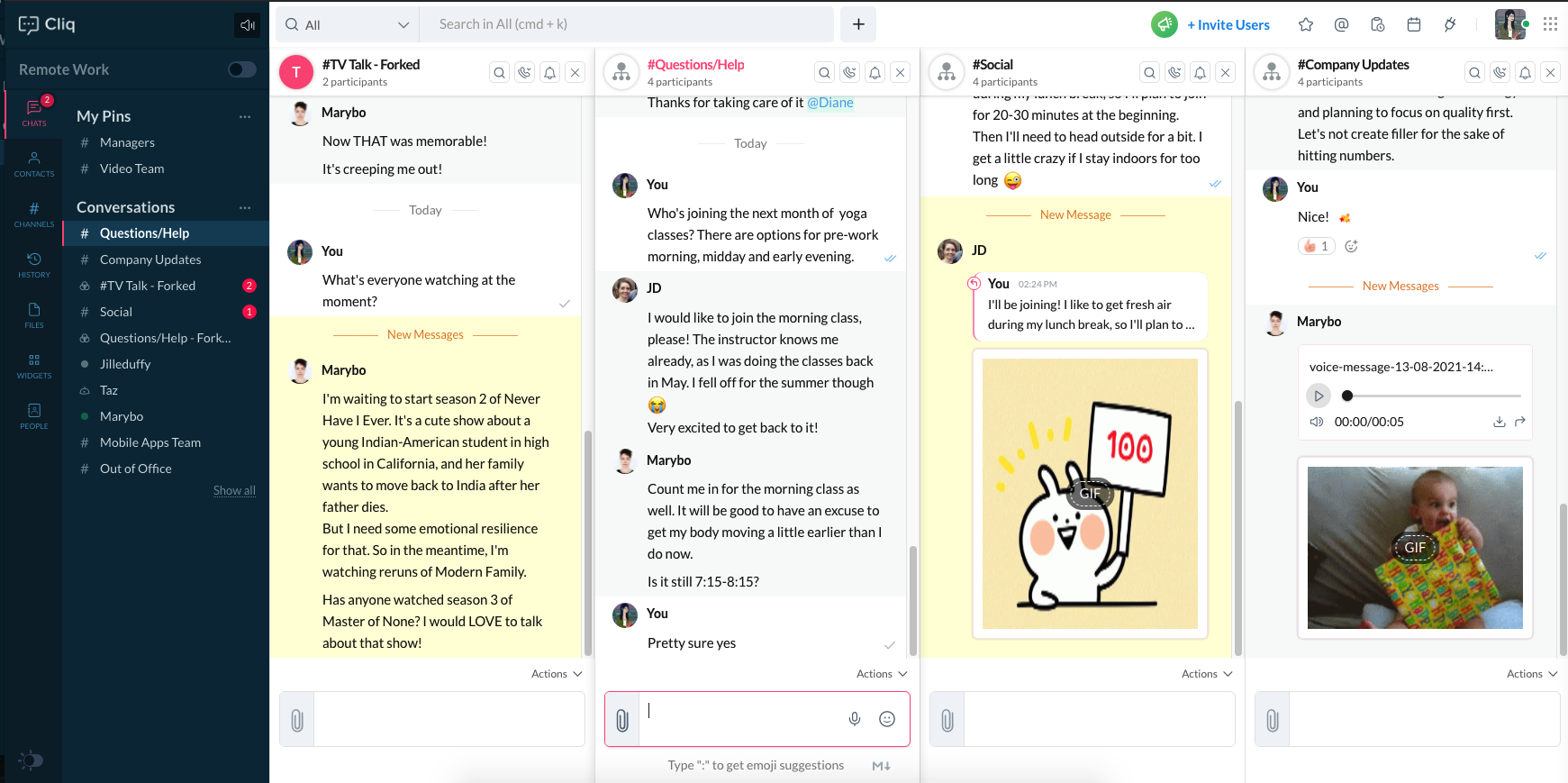Overview
-
Jump To Details
![Slack]()
Slack
Best for Features and Integrations -
Jump To Details
![Microsoft Teams]()
Microsoft Teams
Best for Microsoft 365 Organizations -
Jump To Details
![RingCentral Video]()
RingCentral Video
Best for Free Tier of Service -
Jump To Details
![Twist]()
Twist
Best for Distributed Teams -
Jump To Details
![Flock]()
Flock
In-app Collaboration -
Jump To Details
![Zoho Cliq]()
Zoho Cliq
Best for Low Price -
Jump To Details
![Google Chat]()
Google Chat
Best for Google Workspace Users
You Can Trust Our Reviews
Deeper Dive: Our Top Tested Picks
-
![Slack]()
Slack
Best for Features and IntegrationsBottom Line:
Slack is an excellent and powerful team messaging app with a rich collection of settings and options. It's among the best, but it's also the most expensive.-
Pros
-
Cons
Learn More Slack Review -
-
![Microsoft Teams]()
Microsoft Teams
Best for Microsoft 365 OrganizationsBottom Line:
Teams provides features galore, including tight connectivity with other Microsoft apps. It's a good messaging and video calling app if your organization runs on Microsoft.-
Pros
-
Cons
Learn More Microsoft Teams Review -
-
![RingCentral Video]()
RingCentral Video
Best for Free Tier of ServiceBottom Line:
RingCentral Video is a high-value, low-cost video conferencing and team messaging platform. It's hard to argue with a free plan that offers so much value. Still, you may prefer a service with Q&A moderator tools and mouse/keyboard sharing, which RingCentral Video lacks.-
Pros
-
Cons
Learn More RingCentral Video Review -
-
![Twist]()
Twist
Best for Distributed TeamsBottom Line:
Twist by Doist takes on team messaging and adds an air of calm to it. The app is excellent for teams that are spread across time zones.-
Pros
-
Cons
Learn More Twist Review -
-
![Flock]()
Flock
In-app CollaborationBottom Line:
Team messaging app Flock provides reliable collaboration tools, but a slow pace of improvement and a big price hike make it a less attractive option than it was the last time we tested it.-
Pros
-
Cons
Learn More Flock Review -
-
![Zoho Cliq]()
Zoho Cliq
Best for Low PriceBottom Line:
The low-cost Zoho Cliq borrows many of the best features from team messaging apps like Slack and lets you monitor multiple channels in one window, but it could use better customization options.-
Pros
-
Cons
Learn More Zoho Cliq Review -
-
![Google Chat]()
Google Chat
Best for Google Workspace UsersBottom Line:
Google Chat isn't compelling enough to warrant setting up a Google Workspace account for your team messaging needs, but, if you're already invested in Workspace, it's suitable for quick communication.-
Pros
-
Cons
Learn More Google Chat Review -
Buying Guide: The Best Business Messaging Apps
Ever since Slack won workers' hearts, business messaging apps—also called team messaging apps, because you can use them outside of a business setting—have become the de facto medium for intra-office communication. These apps put instant messaging, text messaging, private forums, video calls, file sharing, and sometimes screen sharing, into one collaboration hub. The result is a single place to chat with or ask questions of colleagues, both in real time and asynchronously. Team messaging apps are among the best productivity tools because they make conversations easier to track, improve teamwork, and help maintain company culture.
With COVID-19 keeping some workers at home, more people are realizing the social and interpersonal value of these apps, too. They help co-workers foster connections and get to know one another better. When co-workers deepen their understanding of one another's personalities, it improves communication all around.
Business messaging apps have several advantages over email, which continues to be a productivity black hole. 1) They encourage brevity. Due to these apps' layouts and evolving etiquette about using them, messages tend to be succinct, unlike email where many feel compelled to over explain. 2) Most discussions occur on an opt-in basis. You can join conversations that are applicable to you, and you're equally welcome to skip anything irrelevant. If you're needed, someone can put an @ sign before your name to flag you. That's much clearer than being CCed on an email when you have no idea what your role in the conversation should be. 3) Messaging apps allow for persistent, ongoing conversations, which isn't a strong suit of email. Open a forum called Brainstorming, and people can add an idea whenever it strikes them.
Everyone Loves Slack, Right?
Slack is one of the most well-known and loved of all team messaging apps. There are plenty of alternatives to Slack, but this app made significant headway in adoption early in its life. Once Slack found its legs, a healthy marketing push didn't hurt either. According to CNBC, the company spent $104 million on marketing in fiscal year 2017, and the figure has doubled since then.
Aside from getting the word out early, Slack also became something of a darling because it was so different from email. It embraced playfulness with emoji, reacji (emoji used as a reaction to a post), and animated GIFs. The app has also continued to add value by growing its feature list. If you're familiar with Slack, you might remember when it added customizable status alerts, threaded messages, or the ability to forward emails into the app. Plus, Slack integrates well with dozens of other online apps and services. If you need to get alerts about activity from another app, chances are you can get them in Slack.

Of course, not everyone adores Slack. Some find it too busy, too noisy, and visually overstimulating. There are a few settings and options to make Slack less distracting, however, and can improve your experience with it.
Slack Alternatives
Slack is hardly the only team chat app on the market. There are plenty of alternatives to Slack, and the ones that have scored highest of those we've tested and reviewed have made it to this list.
Twist by Doist is a great example. It was built by an internationally distributed team who have worked 100-percent remotely for years, even before the COVID-19 pandemic. As a result, Twist is designed to support asynchronous communication across time zones. This means the layout of the app makes it easy to read and track conversations no matter when you catch up on them.
Flock is another option. It has many of the same features as Slack; it's just not overloaded with them. And it costs less. The app has a tidy interface, an integrated to-do list, and the option to make a read-only message board, which could be used to broadcast information from a legal department, HR, or company executives.
Bundled Options
Another way to keep costs low is to use a team messaging app that comes bundled with other services that your organization already pays for. Three examples are Microsoft Teams, Google Chat, and RingCentral Video.
Microsoft Teams comes bundled with Microsoft 365 Business and Enterprise accounts. So if your employer already pays for Microsoft apps, there's a good chance you already have access to Teams. The benefit of using Teams is it integrates with other Microsoft 365 apps you might use, such as Outlook and OneNote. There's a free version of Teams as well, which you access using any Microsoft login, such as Outlook.com email address. If your organization is on the fence about using Microsoft Teams because it already uses Slack, take a look at what makes Teams and Slack different. It may help you decide whether to switch.

Similar to Microsoft Teams, Google Chat comes included with a Google Workspace account. At present, everyone with a Google login can get a Google Workspace account, regardless of whether they're a paying business (though that fact may change). Google Chat isn't the strongest or most feature-rich team messaging app, but it gets the job done.
RingCentral Video is another suite of services that includes team chat functionality. Previously, RingCentral had two separate products: Meeting for web conferencing and Glip for team messaging. Both have been rebranded and rolled together into RingCentral Video, a package targeted at small to medium-sized businesses. RingCentral has products for larger businesses that include team messaging as well, namely RingCentral MVP.
Another video conferencing service, Webex, has taken a tack similar to RingCentral by rolling team messaging into its suite of services. PCMag hasn't yet reviewed the team messaging piece found in Webex App (for small businesses) and Webex Suite (for larger organizations), though we hope to after the company's next release of updates to the offerings.
Best Value for Small Businesses
Many small organizations can get away with using the free version of a messaging app. Usually, the free version limits how many messages it will look through when you run a search, or it will have a low storage cap on uploaded files.

Small businesses that need a fully featured team messaging app at a low price should look to Zoho Cliq. It has the lowest prices we've seen. For the first 500 people, the rate is $3 per person per month with a discount for paying annually. Once you have more than 500 people on the team, Zoho charges a lower rate for each additional user. The rate drops even further the more people you have, down to as little as $1 per person per month.
Communicate, Collaborate
A team messaging app might not be the only collaboration tool your team uses that includes messaging functionality. For example, some project management software includes messaging functionality. Those in-app chat tools are useful for supporting discussions related to the project at hand, but they're not suited for more general conversations, such as getting updates from the leadership team or upper management in your organizations, or hosting a virtual book club among co-workers. So, there are some advantages to having both messaging apps and other collaboration tools that contain more ways to communicate.
The most important thing a team messaging app can do is to support everyone on a team by giving them one of the many tools they need to communicate and get work done efficiently.





















